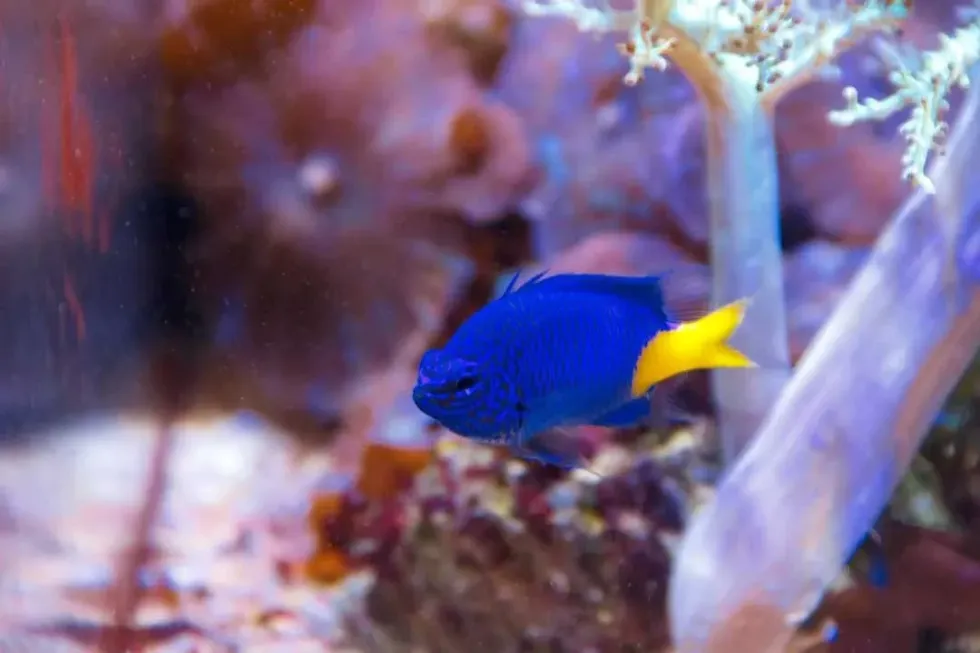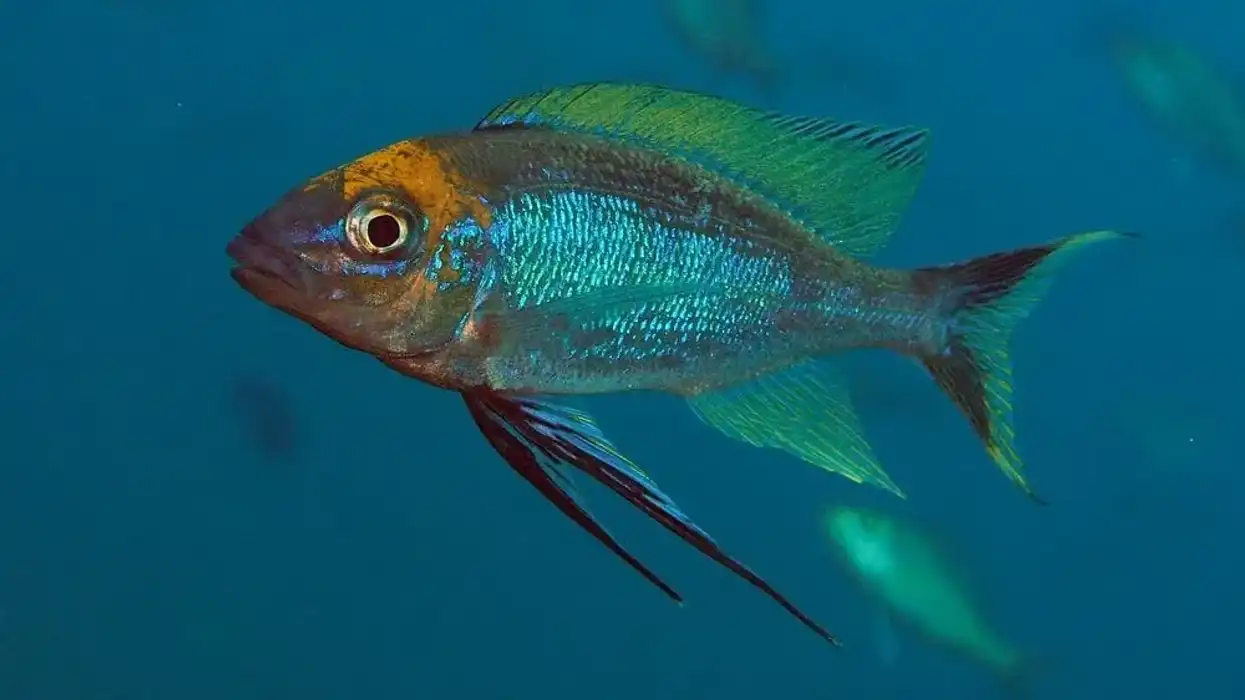The yellowtail damselfish is also known by its binomial name Chrysiptera parasema. It is a very popular species of saltwater fish that is also kept in an aquarium as pets. The yellowtail blue damselfish are native to the reefs of the Indo-Pacific and are mostly found around the countries like Japan, the Philippines, and Australian regions.
These fish are known to be one of the most common fishes kept as a pet in saltwater aquariums and community tanks because they are very tolerant fish and are inexpensive and hardy fish.
However, these fishes have special requirements like specific temperature, minimum tank size, pH levels, optimal care level, so their temperament remains stable enough to be kept as a pet.
One of the most important requirements is a high level of nitrates in the tank, and this is a problem for their tank mates as most fishes cannot tolerate high levels of nitrate, even if they could for some time, these tank mates can end up dying.
Other than that, they required 20 gal (75.7 L) of minimum tank size to live.
The damselfish yellowtail is also known to be aggressive. You can say that they are semi-aggressive marine fish because they tend to show very aggressive territorial behavior towards other small groups. They will ensure that your aquarium is not a peaceful one if you introduce newer fish to the tank.
Here on our page, we have lots of amazing facts about yellowtail damselfish that everyone will enjoy. Let's look at these interesting facts; if you like these, do read our brown trout facts and remora facts for more.
Yellowtail Damselfish Interesting Facts
What type of animal is a yellowtail damselfish?
The yellowtail blue damsel (Chrysiptera parasema) is a small marine fish species found in saltwater. These fish are very beautiful and attractive but are very hardy and tend to show aggression.
What class of animal does a yellowtail damselfish belong to?
The yellowtail blue damsel or Goldtail Demoiselle is a small marine fish that belongs to the class of Actinopterygii fishes.
How many yellowtail damselfish are there in the world?
The yellowtail blue damsel (Chrysiptera parasema) is a very common damselfish species found everywhere in the Indian and Pacific Oceans and kept as pets in saltwater aquariums. For this reason, the exact population of this fish is hard to estimate as they are spread across many households and aquariums.
Where does a yellowtail damselfish live?
The yellowtail blue damsel is a very commonly found species in the Indian and the Pacific Ocean regions. The neighboring countries where they are mostly found are Japan, the Philippines, and Australia.
What is a yellowtail damselfish habitat?
The yellowtail blue damsel inhabits the saltwater bodies like oceans, deep seas, lagoons, inshore reefs, and other deep marine bodies. This species is also kept in aquariums and community tanks despite their not so peaceful and aggressive behavior.
These hardy species are kept in the big gallons tank or a minimum of 20 gal (75.7 L) or more. Despite their small size, they require a tank of more than twenty gallons.
Who does yellowtail damselfish live with?
Yellowtail blue damselfish are the least compatible fish as they show a semi-aggressive behavior towards other species. Suppose they are kept with their own kind or other subspecies of damselfish that show similar aggressive behavior.
In that case, they are good to go, and your tank can hopefully have a peaceful ambiance.
Also, ensure that you place these fish in small groups not to show a lot of aggression. The most compatible fishes kept with these semi-aggressive species are dottyback fish, tangs, six-line wrasse fish, clownfish, and other species of damselfish.
How long does a yellowtail damselfish live?
A yellow-tail blue damselfish's life span and life cycle can last for up to 2-6 years in the wild. These fish can also live more in captivity for around 15 years of age if it is kept in an ideal environment.
You have to feed them proper food also to ensure that they do not fall ill. Also, ensure that the temperature in the tank is optimum to prolong their life cycle.
How do they reproduce?
The yellow-tail blue damselfish becomes more aggressive during the breeding period.
The female fish chooses the male by visiting his territory, and when she finds the perfect one, she stops swimming in front of this male and displays a light ring around her eyes.
After the reproduction process is done, the job of the males is to guard their eggs and nothing more, while females find the nesting site for which they are very picky and then lay eggs where they like to.
They then start the feeding process after the eggs hatch.
When in captivity, the process is very easy as the pair comes together, and after eggs are laid, they hatch in a couple of hours or in one and a half days. It is better to keep the lights off in the aquarium.
After that, when the larvae emerge, they go into hiding.
At this stage, you can try to give them as much light as you can for them to survive. In around 15-40 days, you can see that your larvae become full-grown adult fish and are not juveniles anymore.
What is their conservation status?
The half-blue damselfish are categorized as Least Concern by the IUCN Red List, meaning that they will not be vulnerable anytime soon.
They do not require any conserving as these fish are large in numbers and are constantly breeding in water, be it in open water or an aquarium, and they also lay a large number of eggs, around 300 at a time.
Yellowtail Damselfish Fun Facts
What do yellowtail damselfish look like?
The yellowtail damsel is a small in size hardy fish around 3 in (7.6 cm) in length with an intense blue color body and a yellow tail-fish. Except for the tail and dorsal fins, there is no yellow color on the body of the fish.
Some of the fish of this species may have a pelvic fin, anal, and pectoral fins in yellow color but other than that, the fish is found in intense blue color. The dorsal fins are spiny in shape and maybe laterally compressed.
How cute are they?
Yellowtail damsels are very cute and attractive fish species to be found in the water. Because of their attractive appearance, they are kept as pets in an aquarium and community tank despite their hardy nature.
How do they communicate?
The communication process between yellowtail damsels takes place by the vibration that they produce with their bladders. They usually use their sense of smell to locate the other fish species and their food, like shrimp and green algae.
How big is a yellowtail damselfish?
The size that yellowtail damsels can grow is up to 3 in (7.6 cm) in size. These are small in size water fish and can be five times smaller than the common dolphins.
Although these are of the smaller fish kind, they need a large space if kept in an aquarium as they tend to show territorial behavior, resulting in stress and aggressive behavior in your aquarium.
How fast can a yellowtail damselfish swim?
The average range of speed that the yellowtail fish can swim is not estimated or measured yet, but it is said that these species of fish are very good swimmers and can swim at a high range like most fast fish.
How much does a yellowtail damselfish weigh?
The weight depends upon the size and shape of the yellowtail damsel as they can grow large in shape during captivity if the feeding is well. However, the average weight of the adult fish is around 9.9 oz (283 g) in total. They're twice the size of a swordtail.
What are the male and female names of the species?
The adult does not have a specific name for the females and males. They are referred to as male yellowtail damsels and female yellowtail damsels.
What would you call a baby yellowtail damselfish?
Like every other offspring of marine fishes, the baby yellowtail damsel is also known as fry. When the fry is young and has just emerged from the eggs, they are very shy and stay in hiding for the time being. The parents feed them and take care of them until they are old enough to survive independently.
What do they eat?
The food and diet that a yellowtail damsel prefers to eat is everything from small crustaceans to the green algae. These fish are omnivorous creatures, and the normal diet which they feed on is zooplankton.
When they are kept in tanks, they can also be feed on a diet with frozen shrimp and prawns. They do not eat corals, but they start sucking on the polyps on the coral reef until they eventually die.
Are they dangerous?
Yellowtail damsel fish are aggressive, but they are not dangerous to humans. These fish don't like small creatures, and they like to harass other fishes, and they sometimes attack them if they are in their territories.
Would they make a good pet?
The yellowtail damsel is a very common fish to be kept in the tanks. These fish species are very hard to maintain, and they have many requirements that are meant to fulfill to keep them, but this doesn't stop fish enthusiasts.
Although these creatures are a handful, they are quite famous pets to keep in the tank. The reason behind this could be their cute appearance, which makes people fall for them.
Did you know...
The largest yellowtail damsel is 14 in (35.5 cm) in length.
Yellowtails can change the color of their body as these fish contain chromatophores, which are the cells that produce colors, which can help them change color in response to stimuli. Usually, yellowtails change color and turn darker than the usual intense blue when these fish are stressed out. The change in color helps them conserve their energy easily.
Although yellowtails are aggressive, they like to live with peaceful tank mates to ensure that those fishes are not notorious with them.
Vanderbilt chromis, blue reef chromis, and clownfish are a few of the least aggressive damselfish.
Do damsels kill other fish?
Yes, the constant attack by the damselfish can kill the other fish species. As you know, the damsel is a very territorial fish, and because of that, they get aggressive and attack other fish with their hard dental plate and strong bites.
Do damsels and clownfish get along?
Yes, the damsel and clownfish can be kept together in the same tank. Both fishes temperament is quite the same as both are aggressive and show a territorial behavior. That is why they do not stress each other out.
Here at Kidadl, we have carefully created lots of interesting family-friendly animal facts for everyone to discover! For more relatable content, check out these zebra shark facts and barb fish facts for kids.
You can even occupy yourself at home by coloring in one of our free printable yellowtail damselfish coloring pages.









